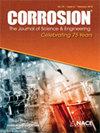Environment-Induced Crack Initiation in Aluminum Alloys – Experimental studies since the 1950’s and future opportunities
IF 1.1
4区 材料科学
Q4 MATERIALS SCIENCE, MULTIDISCIPLINARY
引用次数: 0
Abstract
The initiation of environment-induced cracking (EIC) in aluminum alloys typically dominates the total life during both service-life for structural applications and for smooth tensile test specimens subjected to conventional standard EIC testing. Experience and literature published over the past 70 years have been reviewed, and in some cases re-interpreted. The authors propose we are now well-positioned to use today’s advanced experimental techniques to properly elucidate the EIC initiation phenomena for aluminum alloys. EIC initiation typically involves at least three stages: incubation, intergranular cracking that may ‘arrest’ and a transition to propagating cracks where the mechanical driving force exceeds a threshold, KIEIC, and a surface feature has become a crack potentially propagating at mm/yr. Alloy developers, product designers and commercial users now need quantitative EIC initiation and growth data from accelerated laboratory testing that is directly relatable to actual surface conditions and the expected service conditions.环境致铝合金裂纹萌生——1950年代以来的实验研究及未来机遇
环境诱发裂纹(EIC)在铝合金结构应用和经受常规标准EIC测试的光滑拉伸试样的使用寿命中通常占主导地位。对过去70年来发表的经验和文献进行了回顾,并在某些情况下进行了重新解释。作者提出,我们现在有能力利用当今先进的实验技术来正确地阐明铝合金的EIC起爆现象。EIC的启动通常包括至少三个阶段:孕育,可能“停止”的晶间裂纹,以及在机械驱动力超过阈值时向扩展裂纹过渡,KIEIC,表面特征已成为可能以毫米/年速度扩展的裂纹。合金开发商、产品设计师和商业用户现在需要从加速实验室测试中获得定量的EIC起始和生长数据,这些数据与实际表面条件和预期的使用条件直接相关。
本文章由计算机程序翻译,如有差异,请以英文原文为准。
求助全文
约1分钟内获得全文
求助全文
来源期刊

Corrosion
MATERIALS SCIENCE, MULTIDISCIPLINARY-METALLURGY & METALLURGICAL ENGINEERING
CiteScore
2.80
自引率
12.50%
发文量
97
审稿时长
3 months
期刊介绍:
CORROSION is the premier research journal featuring peer-reviewed technical articles from the world’s top researchers and provides a permanent record of progress in the science and technology of corrosion prevention and control. The scope of the journal includes the latest developments in areas of corrosion metallurgy, mechanisms, predictors, cracking (sulfide stress, stress corrosion, hydrogen-induced), passivation, and CO2 corrosion.
70+ years and over 7,100 peer-reviewed articles with advances in corrosion science and engineering have been published in CORROSION. The journal publishes seven article types – original articles, invited critical reviews, technical notes, corrosion communications fast-tracked for rapid publication, special research topic issues, research letters of yearly annual conference student poster sessions, and scientific investigations of field corrosion processes. CORROSION, the Journal of Science and Engineering, serves as an important communication platform for academics, researchers, technical libraries, and universities.
Articles considered for CORROSION should have significant permanent value and should accomplish at least one of the following objectives:
• Contribute awareness of corrosion phenomena,
• Advance understanding of fundamental process, and/or
• Further the knowledge of techniques and practices used to reduce corrosion.
 求助内容:
求助内容: 应助结果提醒方式:
应助结果提醒方式:


